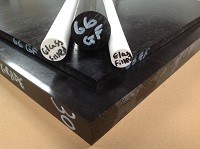Could Glass Filled Engineering Plastics be the answer to your prayers?
If Like us you ever wondered what glass filled nylon or PTFE or other engineering plastics was all about, or did you even know that these every day engineering plastics even had a glass filled grade? Either way there surely must be an important point to them we thought, so we dug a little deeper and this is what we discovered.
So which plastics are available in GF grade?
It’s the most common engineering plastics such as Nylon 6 & Nylon 66, Acetal, PTFE and PEEK that all have a glass filled option, what we discovered though is that the % of glass that is added varies, some it’s as low as 20% glass added then 25% and finally 30% glass depending on the actual material but obviously the higher the % the greater the influence of the glass filler.
What actually is the “glass”?
Its normally just a powdered glass that is incorporated into the mix at the manufacturing stage and then the resulting material is then extruded normally through the usual dies and rollers. It doesn’t sound much fun for the dies and or rollers in this case as GF grade is pretty abrasive, OUCH!
The “first” big question
What does this “glass” stuff actually do? Well it will increase the stiffness substantially and by upto a whopping 80% more than the standard grade. It will also increase its tensile strength by an amazing 70%, so now you can start to see why this GF stuff is starting to look a bit interesting. Here’s another little trick up its sleeve, its thermal expansion rate is about half that of its unfilled relative. What this means is that as the temperature goes up or down and your components would normally move all over the place, GF grades tend to stay where they are, or at least move around a whole lot less. The 30%GF grade is also 50% harder than its unfilled relative which is a big bonus for PTFE which is a bit tricky to machine at the best of times. What doesn’t seem to change much though is the operating or working temperatures, they stay pretty much the same.
The “second” big question
As we know, for every silver lining there’s always a cloud, so what is the rub as they say with GF grades. Well the price for one as it’s typically around 2 ½ times the price, which means that if an item costs £8 for nylon 66, the same item could cost around £20 in GF grade. There’s another big consideration and that’s the machining side, glass filled nylon is recommended to be heated and soaked in an oven and then machined whilst hot, now that’s not the easiest task in the world, never mind the fact that Its also a bit harsh on cutting tools due to the abrasiveness of the glass.
The wear resistance is actually pretty great though as you would expect but keep an eye out for your mating parts as the glass can actually wear them away. The electrical insulating characteristics may be affected though because of the glass content and its also about 15% heavier if that has any relevance.
In summary
If you’re looking for a super strong, very rigid and super stable plastic then the glass filled grades have really got to be worth a closer look, they certainly offer a real advantage but you have to factor in the potential machining technicalities and also if you’re on a budget which is very often the case, it could be the cloud to your silver lining.










